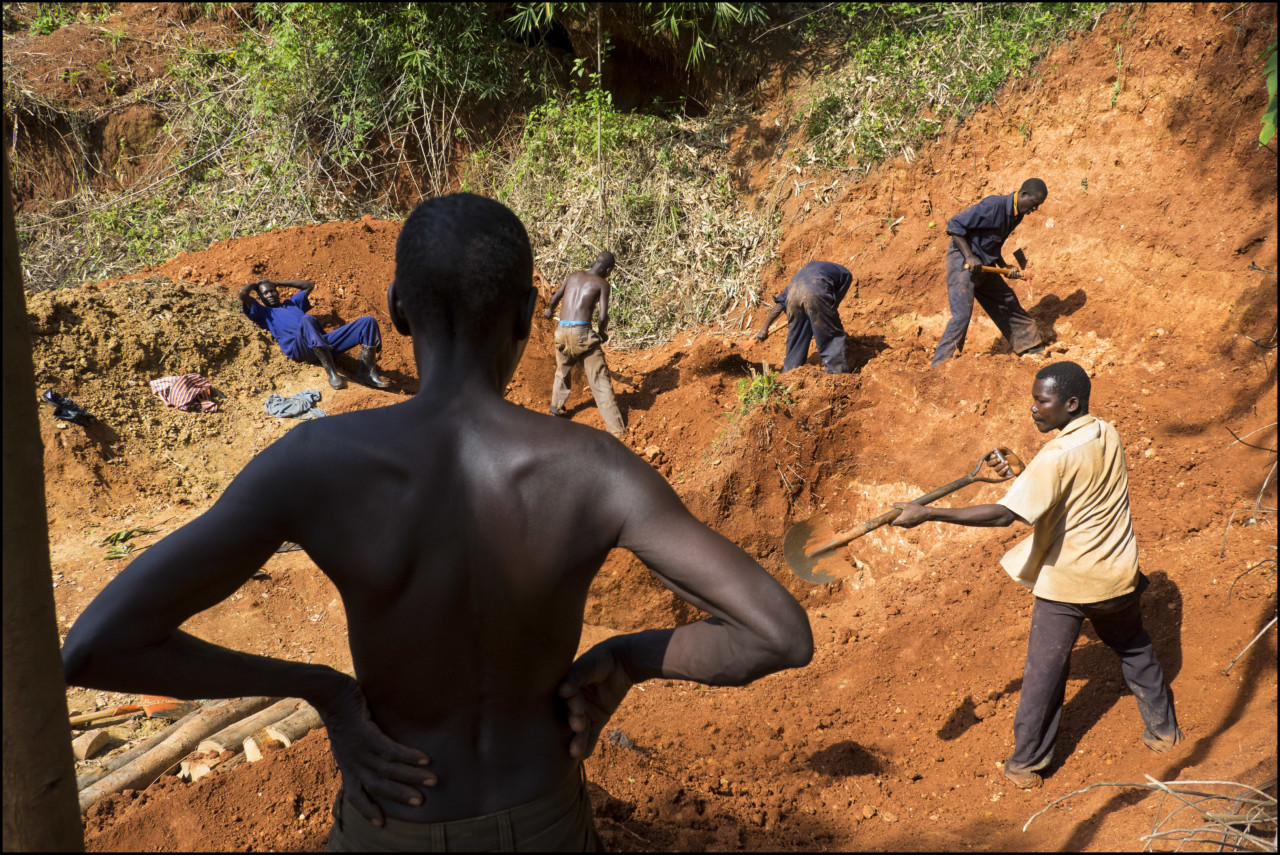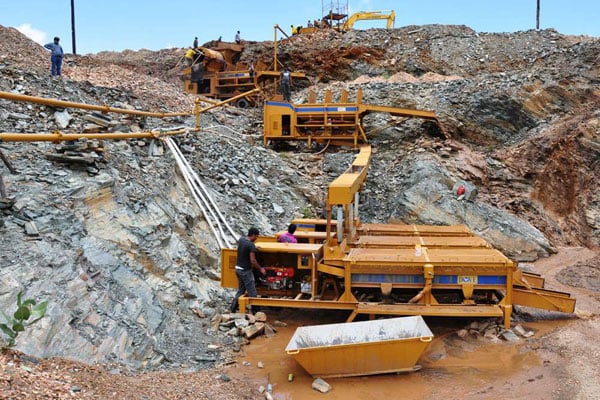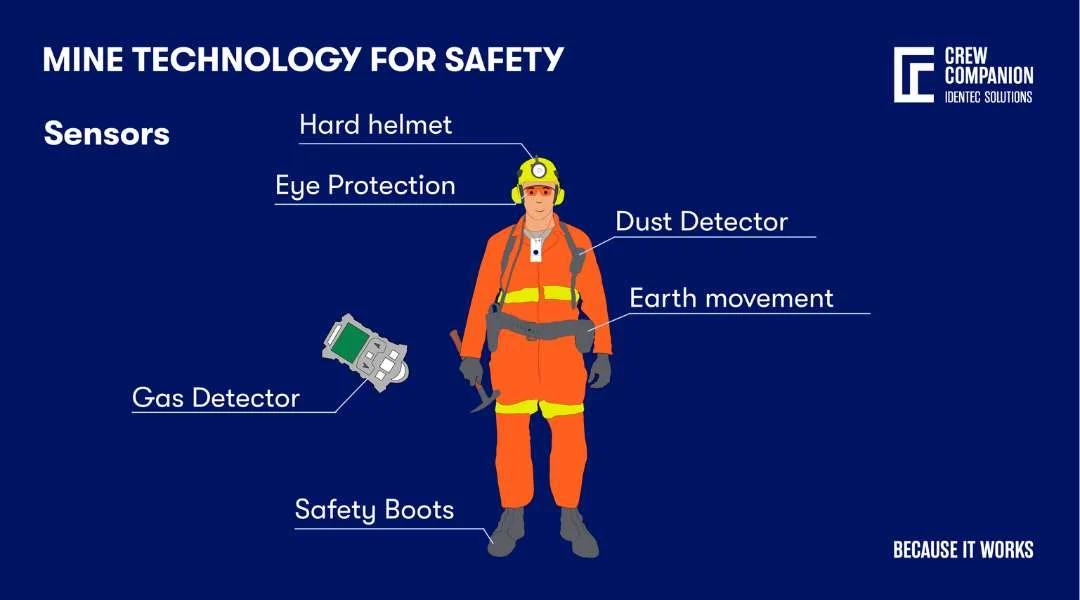Uganda Mining Company in 2024
Imbuing the Past: The History of Mining in Uganda
In the verdant heartlands of East Africa, the rich tapestry of Uganda’s mining history unfurls. As integral as the River Nile to its geography, mining in Uganda traces back to prehistoric times when primitive man exploited its bounteous deposits of stones and minerals for tools and dye.
Their historical relics bear testament to the country’s earliest interaction with its mineral wealth. The landscape changed significantly in the early 1900s during colonization when systematic mining was first introduced by British colonists.
With an eye on exploiting copper reserves, they established Kilembe Mines Limited in 1956, marking a pivotal moment in Uganda’s mining history. However, following independence and subsequent political instability in the 1970s, operations were largely disrupted leading to significant declines until resurgence in recent decades.
Embracing Potential: An Overview of Uganda Mining Company
In this unfolding narrative stands a beacon of promise – The Uganda Mining Company (UMC). Established during a time when mineral exploration was gaining momentum post-political instability, UMC has grown into a formidable force within Uganda’s economic landscape.
From humble beginnings primarily dealing with copper extraction from Kasese district mines inherited from colonial remnants, UMC has steadily expanded both its scope and scale. Today, UMC represents a wide array of minerals including gold, copper and cobalt among others.
Driven by a commitment towards responsible and sustainable practices undergirded by cutting-edge technology; it continues to make significant strides towards effective mineral exploitation while being mindful of environmental impact. Its robust strategies have positioned it as more than just an extractive entity – rather as an institution contributing significantly not only to national economic growth but also playing key roles towards community development and social welfare initiatives.

The Bedrock of Progress: The Foundation of Uganda Mining Company
The inception of Uganda Mining Company was not a serendipitous event but rather a meticulously planned endeavor. The founding vision was to create an entity that would exploit the vast mineral resources Uganda is endowed with, transforming them into wealth that would catalyze national development. This vision was underscored by a mission rooted in effective and efficient exploration, extraction, and processing of minerals in a sustainably responsible manner.
Integral to this vision was an aspiration to be globally competitive and to contribute significantly to the economic growth of Uganda. The founders envisioned a mining company that would uphold high standards of professionalism, ethics, and corporate governance while simultaneously promoting innovation and technological advancement in all its operations.
The Pillars: Key Individuals Involved in the Establishment
Several extraordinary individuals were instrumental in creating the solid edifice known as Uganda Mining Company. Among them were seasoned geologists, astute business tycoons, far-sighted policymakers, and dedicated environmentalists. One such individual was Dr. John Kigongo Mubiru; renowned for his forensic geological skills and unparalleled knowledge on mineral deposits within East Africa region.
Another key contributor was Siraj Kalyango who brought on board substantial financial muscle along with requisite business acumen needed for such an enterprise. Equally vital were Honorable Nyakahuma Otafiire’s policy-making prowess which greatly influenced favourable legislative environment for mining operations; and Rebecca Babirye’s passion for environmental conservation which ensured sustainable practices were entrenched within the company’s operations from inception.
Precious Seeds: Initial Capital & Resources
The setting up of Uganda Mining Company required substantial initial capital investment. It is reported that an approximate figure close to $50 million dollars formed the base financial resource for the company.
This capital was used to acquire essential machinery, secure mining rights and licenses, and set up processing plants. Even more significant than financial resources were the intangible resources that came in form of industry knowledge, business expertise and vast networks brought by the founding members.
Their collective experience formed a crucial resource that guided the company through its nascent stages to the global mining giant it’s gradually becoming. With this fortuitous synergy of visionaries, Uganda Mining Company was poised for greatness from its inception.
Exploration and Extraction Processes
The Intricacies of Mineral Exploration
The mineral exploration process commences with thorough geological surveying, a pivotal stage that assists in understanding the geographical structure of potential mining sites. Geologists employ various geospatial technologies such as remote sensing and geophysics to map the Earth’s surface and subsurface structures.
These studies provide crucial information about rock formations, fault lines, and possible mineral deposits. After geological surveying is the sampling and analysis stage.
In this phase, materials from the prospective site are meticulously gathered for laboratory testing to determine their mineral content. State-of-the-art spectroscopic equipment is used to identify the minerals present in samples accurately.
This stage serves as an effective tool in gauging whether a site possesses commercially viable quantities of minerals. Drilling for further data collection then ensues after successful sampling and analysis operations.
Drilling provides an in-depth understanding of a potential mining site’s ore body by generating samples from deeper beneath the Earth’s surface. The extracted cores are subjected to rigorous tests for mineral content and quality assessments. 
Decoding Mining Techniques: Open-Pit & Underground Mining
The Uganda Mining Company majorly employs two distinct techniques for extraction: open-pit mining and underground mining. Open-pit mining, also known as opencast or open-cut mining, is favored when valuable deposits occur near the surface or where overburden—the non-valuable rock overlaying valuable minerals—is relatively thin or soft. This method utilizes large excavation methods such as drilling, blasting, and cutting to extract ore.
It involves sequential removal of layers until all viable resources are exhausted—an economical choice due to its lower operational costs compared with other methods. Contrarily, underground mining is employed when mineral deposits reside deep within Earth’s crust—where overburden removal would prove excessively arduous or potentially detrimental to the surrounding environment.
Access to these deep-seated deposits is achieved via shafts or adits (horizontal entrances), and extraction occurs through various methods like longwall mining, block caving, or sublevel caving. Despite its higher operational cost compared to open-pit mining, underground mining is favored for its lesser environmental impact and capability to access valuable minerals beyond the reach of surface excavation techniques.
Major Minerals Mined by the Company
The Golden Bounty: Unraveling the Treasure of Uganda’s Earth
The company’s primary mineral resource, gold, has been a pivotal element in its success. The deposits are mainly located in regions like Busia, Karamoja, and Buhweju.
The extraction process involves both placer and hard rock mining methods. Placer mining capitalizes on gold particles in riverbeds and valleys where gravity pulls them down and they get trapped.
Hard rock mining requires more sophisticated techniques to extract gold embedded in rocks deep beneath the earth’s surface. After raw extraction, the ore undergoes a series of processing stages including crushing, grinding, concentrating, pre-roasting, and final roasting.
The high market value of gold impacts Uganda Mining Company’s revenue significantly. Gold’s use in jewelry, investments, and electronics, due to its conductivity and tarnish resistance, contributes to this. Gold extraction forms a major part of the company’s annual earnings. This has made it a leading corporate entity in Uganda.
Copper: An Unsung Hero Boosting Ugandan Economy
Minerals like Copper play a discreet yet significant role within Uganda Mining Company’s portfolio. Copper deposits primarily lie within central Uganda’s Kilembe area.
The extraction method largely employed is open-pit mining which involves removing overburden material (soil or subsoil) followed by ore extraction using heavy machinery. The significance of copper extends beyond just financial revenue for this firm; it also contributes greatly to the broader Ugandan economy by encouraging foreign investments as well as providing jobs locally.
Copper is used extensively across various industries such as construction (for electrical wiring), transportation equipment manufacturing (for motors), electronics (for circuitry), and more. The vast application of copper heightens the demand for this mineral, further bolstering the company’s revenue.
Cobalt: A Modern Marvel Influencing Worldwide Markets
Cobalt, a by-product of nickel and copper mining, has emerged as another important mineral within Uganda Mining Company’s portfolio given its rising global demand, especially in high-tech industries. It is essential for the production of superalloys utilized for jet engines; it is also a critical component in the manufacturing of rechargeable lithium-ion batteries common in electric vehicles and portable electronics. The extraction process, though challenging due to cobalt’s tendency to exist as a mixed compound rather than pure metal, has been meticulously mastered by Ugandan Mining Company through advanced hydrometallurgical techniques.
Despite these challenges, the increasing market demand combined with high prices makes cobalt an invaluable asset to Uganda Mining Company’s repertoire of minerals. The contribution from cobalt supplements company revenues while reinforcing its commitment to stay abreast with trends shaping global markets.

Types of Technology Used in Operations
Geospatial Technology: The Key to Efficient Exploration
Geospatial technology has emerged as a potent tool in contemporary mineral exploration and has been instrumental in Uganda Mining Company’s operations. This technology employs Geographic Information Systems (GIS), advanced imaging, and satellite-assisted remote sensing for precise mineral targeting.
The use of high-resolution digital elevation models provides an accurate depiction of the terrain, facilitating the identification of potential geological structures or anomalies that may host mineral deposits. In addition, geospatial technology also allows for the integration of various types of data, including geochemical, geophysical, and geological information into a single comprehensive platform.
This amalgamation offers a more extensive perspective on prospective mining areas through 3D modelling techniques. It enables experts at Uganda Mining Company to identify potential prospects efficiently before initiating costly drilling operations.
Embracing Automation: Transforming Mineral Processing
Uganda Mining Company is fast embracing automation in its mineral processing procedures to enhance efficiency and productivity while minimizing human error. Automatic control systems are used to monitor important aspects such as feed rate, pH level, pressure, temperature and other key parameters within the processing circuitry.
By using state-of-the-art control room interfaces with real-time monitoring capabilities, operators can optimize equipment performance leading to enhanced recovery rates. Moreover, automated sorting systems have been incorporated within the primary stages of processing.
Utilizing cutting-edge sensor technology coupled with high-speed pneumatic ejectors based on X-ray transmission or optical sensors identifies quality minerals from waste rock ensuring efficient beneficiation processes. Automation presents a paradigm shift towards smart mining that combines efficiency with sustainability.
Safety Technologies for Miners: Safeguarding Lives Underground
Recognizing that human safety forms the crux of mining operations; Uganda Mining Company invests heavily in safety technologies designed to protect miners from numerous hazards they face. Proximity detection systems are used to prevent potential collisions between miners and machinery, thereby mitigating risks involved in underground mining.
Real-time tracking systems using RFID tags are also employed to monitor the location of every miner, allowing for an efficient evacuation during emergencies. Furthermore, measures to combat the detrimental effects of dust and noise pollution have been instituted through advanced ventilation systems and noise-cancellation technologies.
Personal Protective Equipment (PPE) utilizes technology like anti-vibration gloves, high visibility clothing embedded with micro-prismatic tapes for better visibility, and self-contained self-rescuers that provide miners with a portable source of oxygen in cases of emergencies. These technological advancements underscore Uganda Mining Company’s commitment towards not just productivity but also ensuring its employees’ well-being. 
Unearthed Realities: The Environmental Impact of Mining in Uganda
The Unseen Cost: Environmental Challenges Posed by Mining Operations
The environmental ramifications of mining operations are insidious and often unobserved until the damage is irreversible. Chief amongst these is soil erosion, an inevitable consequence of open-pit mining.
The disruption of the earth’s crust manifests in landslides and floods, consequentially affecting agricultural productivity in adjacent areas. Water pollution is another poignant concern tethered to mining activities.
This pernicious effect occurs when mineral waste infiltrates water bodies, transforming them into toxic cesspools. Heavy metals such as lead and mercury pose significant health risks to both humans and aquatic life residing near these contaminated sources.
Air pollution from dust or hazardous fumes generated during mineral processing can also contribute to deterioration of air quality, not only posing threats to human health but also intensifying global warming. Furthermore, habitat destruction due to mining activities disrupts biodiversity and threatens the survival of species indigenous to the region.
Reweaving Nature’s Tapestry: Sustainability Practices Employed by Uganda Mining Company
In response to these environmental challenges posed by their operations, Uganda Mining Company has implemented several sustainability practices. One such initiative includes effluent treatment processes that ensure harmful waste does not contaminate local water bodies. The company also employs comprehensive rehabilitation programs for mined land.
These include reforestation efforts aimed at restoring flora endemic to mined regions and initiatives to manage soil erosion post-mining through terracing or ground covering with specific plant species. Energy-efficient technologies have become instrumental in reducing carbon footprints associated with extraction process.
Usage of renewable energy sources like solar power for operations where possible, transitioning from diesel-fueled machinery towards more electric-based options are some examples showcasing commitment towards mitigating environmental impact while maintaining efficient production levels. Each step taken towards sustainability not only helps in safeguarding the environment but also fortifies the sustainability of the entire mining industry, ensuring a healthier planet for future generations.
Social Impact & Community Engagement
Employment Opportunities: From Local Communities to the Global Stage

Corporate Social Responsibility: Investing Beyond the Mine
Mining corporations are often criticized for their potential environmental impact; however Uganda Mining Company exhibits remarkable dedication to corporate social responsibility (CSR) initiatives to offset this critique. Key among these initiatives is their commitment towards improving local education facilities. The company funds construction of classrooms and provision of educational resources across schools in mining regions.
Furthermore, it awards scholarships to bright yet underprivileged students within these communities. Beyond education, Uganda Mining Company invests significantly into healthcare development.
They have built health centers equipped with modern medical facilities within reach of remote mining areas providing residents access to reliable healthcare services they previously had no access to. Also noteworthy is their regular organization of free health camps that offer medical check-ups and treatment for common illnesses.
Community Engagement Strategies: Building Sustainable Partnerships
To foster harmonious relationships with host communities around its mining sites, Uganda Mining Company has developed robust community engagement strategies. These include regular community town hall meetings and open days where members of the public can visit the mining site and learn about the company’s operations.
In these interactions, locals are given a platform to voice their concerns, ask questions and provide feedback directly to the company representatives. Furthermore, Uganda Mining Company has integrated participatory decision-making into their operational policies, involving community representatives in decisions that affect them such as land use and environmental management plans.
This level of transparency has established trust between the company and local communities, ensuring that everyone’s perspective is considered in matters pertaining to mining operations. This approach has not only enhanced social acceptance of their activities but also fostered sustainable development within these communities.
The Lustrous Lifeline: Revenue Generation through Mineral Exportation
Uganda Mining Company, as one of the country’s primary mineral extractors, is a key gear in the engine that drives Uganda’s economic prosperity. The revenue generated from exporting valuable minerals such as gold, copper, and cobalt is substantial.
The company excavates these precious resources from the heart of Uganda’s abundant terrain and then exports them to international markets across Europe, Asia, and North America. This export-focused strategy doesn’t simply fuel the company’s financial growth; it nourishes Uganda’s economy at large.
A significant portion of the country’s foreign exchange earnings are attributed to mineral exports. This income allows for investment in other sectors, strengthening the nation’s economic resilience amidst global market fluctuations.
Bedrock of Progress: Role in Infrastructural Development
The influence of Uganda Mining Company on infrastructural development goes beyond mere financial contributions. As a major industry driver, requirements for effective mineral exploration and extraction necessitate robust infrastructure. This includes improved road networks for transportation to remote mining areas and development of power systems to sustain large-scale operations.
Their commitment extends further; in numerous instances, they have directly funded local infrastructure projects. These include building roads that connect isolated communities to larger cities and investing in power grid expansions that illuminate previously darkened regions of Uganda – both literal and metaphorical beacons of progress. 
A Golden Influence: Impact on Local Economies
Charting the Future: Predictions and Expectations
The future of Uganda Mining Company appears to be luminous, holding a kaleidoscope of opportunities and potential. With the continuous advancements in mining technology and equipment, it’s expected that the company’s productivity will proliferate. Automation is foreseen to play an even more pivotal role in operations, enhancing both efficiency and safety standards.
This includes everything from automated drilling equipment to drones for aerial surveys. Moreover, as Uganda continues to emerge as a significant player in the global minerals market, companies like Uganda Mining Company are projected to be at the forefront of this development.
The company plans to expand its exploration activities beyond its current scope in pursuit of new mineral deposits. This not only promises increased revenue for the company but also signifies further contributions towards national economic growth.




